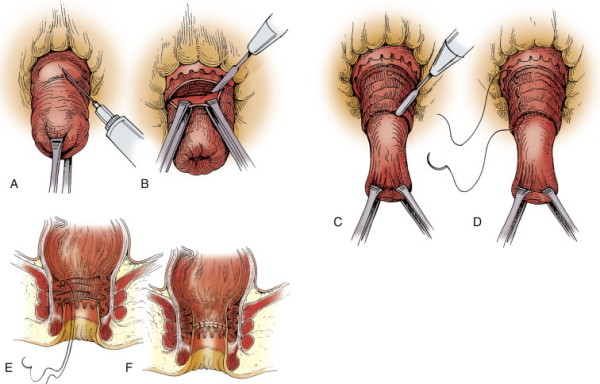- Abscess Incision and Drainage
- Advancement Flap Repair
- Anal Bulking
- Anal Tattooing
- Botulinum Toxin Injection
- Colectomy
- Delorme’s Procedure
- ELAPE Procedure
- Femoral Hernia Repair
- Fistulotomy
- Haemorrhoidectomy
- HALO-RAR Procedure
- Inguinal Hernia Repair
- Intersphincteric APR
- Lateral Internal Sphincterotomy
- Low Anterior Resection
- Pelvic Organ Prolapse
- Perineal Rectosigmoidectomy
- Rectoanal Repair
- Rubber Band Ligation
- Stapled Haemorrhoidopexy
- Stoma Creation
- Stoma Reversal
- Transanal Rectocoele Repair
- Umbilical Hernia Repair
Delorme’s Procedure
Delorme’s procedure is a modification of perineal rectosigmoidectomy, differing only in that instead of the prolapsed portion of bowel being completely removed, only the outer layer of the prolapsed bowel is removed, preserving the muscle layer. The muscle layer is then folded over like a concertina and stitched.
As with perineal rectosigmoidectomy, Delorme’s procedure is relatively simple to perform, with low surgical risk and no need for an abdominal incision. This procedure is generally reserved for less fit patients and can be performed if it is the patient’s preference. You will have the opportunity to discuss fully all the risks and benefits of this operation with me before signing your consent form.

Delorme’s procedure can be performed under general anaesthesia where you will be asleep or under spinal anaesthesia, during which you remain awake. The entire procedure takes about 60 minutes to complete. Regardless of the type of anaesthesia used, you will feel no pain during the procedure.
You will need to fast from midnight on the night before if your surgery is scheduled for the morning, or from 7 am if it scheduled for the afternoon. No special bowel preparation is necessary before this procedure, unless you are also having a colonoscopy in the same sitting. You will receive an enema an hour or so before your surgery. You will be given a long-acting antibiotic in the anaesthetic room and an injection of local anaesthetic before you leave the operating theatre to help keep you pain-free in the 6 hours after your surgery.
After the operation you will be transferred to the recovery area and then to the ward. When you wake up, you will have tubes attached to your body, including an intravenous infusion tube in your arm to give you fluids and any necessary drugs and a catheter in your bladder to drain urine. These are normally in place for 24 hours after this surgery.
You are likely to feel some discomfort after your local anaesthetic wears off, but in most cases this can be managed with simple oral painkillers. You will be able to eat and drink as soon as you feel able (most people are able to do so within hours of their surgery). The hospital stay is usually 3–5 days, but some people might need to remain in hospital longer.
It is important to keep your bowel movements soft and regular and avoid straining while you are recovering from your procedure. To prevent constipation, eat foods high in fibre, and drink plenty of water (6–8 glasses a day). It is also a good idea to take laxatives for 4–6 weeks after your procedure. Analgesia and laxatives will be given to you to take home.
You can expect minor bleeding after your surgery, and a sanitary towel changed twice daily will help to prevent staining of underwear. It is normal to notice bleeding after you have opened your bowels, but if the amount of blood is more than a couple of teaspoons a day, please let my office know.
Normal activities can be resumed immediately following surgery. Some people do take longer to recover. Exactly when patients can resume driving after this type of surgery is determined on a case-by-case basis and this will be discussed with you after your surgery, but is generally 2 weeks after surgery. Please let your insurance company know when you have been given the all-clear to resume driving.
A follow-up appointment in the clinic will be arranged for 1–2 weeks after your surgery to check your wound and discuss any further management if required.

